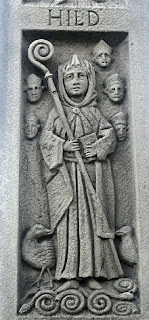St. Edmund's Norfolk Churches

Edmund is patron saint of several parishes in the Norwich Diocese Many are near the coast or rivers; and situated at the top of rising ground, sometimes on mounds, natural or man-made. On the Ely side of the diocecesan border St. Edmund, Downham Market looks out across the fens from the top of the escarpment Some have speculated that the churches marked the burial places of those who fell beside Edmund in the final series of battles against the Great Heathen Army. After his death, St. Edmund the King seems to have been revered by the defeated Anglo-Saxons as a tragic hero; and by the Danes as, in some sense their father His death had brought Danes and Anglo Saxons together in Christian Faith and now championed their cause in heaven. Poppies around a war memoria l, within the churchyard of St. Edmund's, unite two acts of remembrance within one semi-circular boundary . Both have days of remembr...

